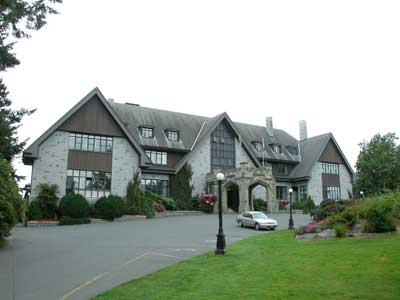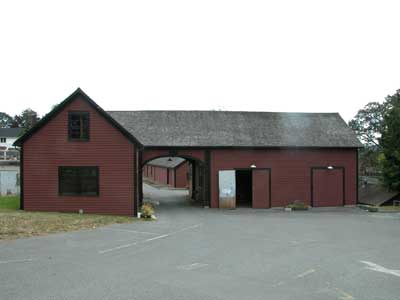Heritage Register
Rockland
1401 Rockland Avenue
(ex-Belcher St)
Oakley; Stoneleigh; Bleak House; Cary Castle; Government House
Built
1859-60; 1899-1903; 1957-58
Heritage-Registered
National Historic Site 2002
Architects: Frederick Walter Green;
John Wright & George Sanders;
Samuel Maclure & Francis Mawson Rattenbury;
BC Dept. of Public Works: Chief Architect Clive Campbell
Alfred Wood, 1909 (porte cochère)
Contractors: William Fuller (1859-60;
Richard Drake (1899-1903)

ARCHITECTURE:
The formal title of this imposing property is The
Estate of the Lieutenant-Governor, Victoria, British
Columbia; it was designated a National Historic Site in
2002. This estate has been the home of BC’s Lieutenant-
Governors since BC joined Confederation in 1871. The
site was a rocky outcrop overlooking Ross Bay at the far
eastern end of the growing city. The first building on this
site burned to the ground three months after construction
in 1852. The history of the mansion, however, falls into
three distinct phases, punctuated by two more fires.
Phase 1: Nothing remains of the 1859-60 building
except auxiliary structures behind and below the residence.
F.W. Green designed the stone Cary Castle, constructed by
William Fuller, for George Hunter Cary, the first attorneygeneral
in 1860. However, the eccentric Cary had little
time to enjoy his “folly” before suffering financial ruin. He
sold the drafty castle to Elizabeth Miles (1462 Rockland
Av), who sold it in 1864 to the colonial government for
$19,000. In 1866 the colonies of Vancouver Island and
British Columbia were amalgamated and Cary Castle became the first Government House. Architects Wright &
Sanders designed additions and alterations for Gov. Arthur
Edward Kennedy. One critic called the result “vaguely
reminiscent of a semi-ruined Scottish border castle.” The
windswept grounds badly needed development but this
was not an easy project. In 1876 when Canadian Gov.-Gen.
Lord Dufferin visited Victoria with his wife, they stayed at
Government House. The Marchioness of Dufferin and Ava
later described in a letter the “nice garden (that) has been
made; the drawback to it is the want of water. Every drop,
both for house and garden, has to be brought in barrels.”
She was less impressed with the view of the Olympic
mountain range, saying that it was “a little wanting in
variety of outline, but extremely high...” Princess Louise,
daughter of Queen Victoria, stayed at Government House
for three months in 1882. She is said to have described the
area as being “halfway between heaven and Balmoral.”
Many additions, alterations and repairs were made over
the years to a building that was notoriously cold and
damp. The roof leaked, the plumbing was problematic and
the house had possibly not been well constructed. There
were several minor fires, one when a coal-oil chandelier
crashed to the floor while being lit. Another fire in 1888
could have resulted in a major disaster, but for the prompt
arrival of the City’s new fire engine in exactly four minutes,
including time to hitch up the horses. However, in May
1899 Cary Castle did burn down, except for the ballroom
and conservatory photos page 112. Lt.-Gov. Dr. Thomas
R. McInnes and his family lost all their personal effects.
Gyppeswyk, 1040 Moss St, Rockland, was rented for $50
per month as a temporary vice-regal residence.
Phase 2: After rancorous debate, Samuel Maclure and
Francis Rattenbury were commissioned to collaborate on
a second Government House. Rattenbury was primarily
responsible for the shell, and Maclure for the interior and
later the landscaping. However, Maclure became ill and
Rattenbury completed the project in 1903. The $75,000
mansion had several jettied, half-timbered gables and
shingled gables, multiple roof-lines and many bays, a
square crenellated stone tower with arrow slits, a round,
shingled and crenellated corner tower, and banks of tall
windows, many with art glass. The final cost was well
over the budgeted $44,000 and the government had
carried only $12,000 in insurance on Cary Castle. Both
Rattenbury and the new Lt.-Gov. Sir Henri-Gustave Joly
de Lotbinière came in for much criticism of their joint
extravagance on the structure. In 1909 Lt.-Gov. James
Dunsmuir (1525 Shasta Pl, Rockland) added a stone
porte-cochère to the front of the building. His new house,
Hatley Park, had one, and he felt that Government House deserved a similar embellishment. It was designed by
architect Alfred Wood and cost $3,429. An ugly incident took place in 1915 when Frank Barnard (1462 Rockland
Av) was Lt.-Gov. His wife Martha Loewen was of German
birth, and a mob tried to attack Government House after
a German submarine sank the Lusitania. Fortunately, the
iron fence and gate, installed a few years earlier, saved the
Barnards and Government House from harm.
Phase 3: A fire on April 15, 1957 that destroyed
the 1899-03 house was thought to have been caused by
hot ashes from the coal cooking range, still in use in the
basement. The wind was high and the fire began in the
early hours of the morning. Only the 1909 porte-cochère
survived the inferno, along with the contents of the wine
cellar, some china and linen, and Lt.-Gov. Frank Ross’s
wife’s jewellery. There was controversy over the design
of a new Government House or indeed if it should be
replaced at all. The Rosses, who lived in the Empress
Hotel during the re-building, favoured a house that would
look as similar as possible to the previous one and these
were the directions given to the BC Dept of Public Works
and Provincial Chief Architect, Clive Dickens Campbell.
Rebuilding began the end of that year but the project was
delayed by a long strike and the new Government House was not ready for occupation until April 1959. Costing
$1.6-million, including furnishings, it was built on the
same T-shaped footprint as its predecessor. Unfortunately,
the architects’ names are omitted from the plaque
celebrating the new building. The three-storey, hip-roofed
mansion has six small dormers on the main roof and three
dominant front-facing gables. Small pent roofs over the
windows on the main floor connect the gables. The 1909
crenellated porte-cochère has dressed sandstone quoins on
buttresses and Tudor arches. There is a tall stained-glass
window over the porte-cochère which extends to the apex
of the central gable. The structure is of steel-reinforced
concrete, clad in grey and coloured Haddington Island
stone, and the windows are metal framed. The chimneys
are stone on the front and brick on the rear. The rear or
south façade, which dominates the precipitous site, has a
large, curved, two-storey bay between two gabled wings.

Of the service buildings, the stable is thought to be the oldest building of its type in western Canada, built in 1872
to replace the original Cary Castle stables. A restoration
project in 2003 included seismic upgrading and some
reconstruction to restore its original appearance. As well
as still providing stabling for visiting horses, the building
contains a display of historic tack and a meeting room.
Other estate buildings include a former jail, stable boy’s
quarters, coal shed and root cellar, all from 1865, and a
laundry from 1903. Butterworth Cottage, built in 1871-72,
was at first a poultry house, then part of it was converted
to a cottage for the gardener, Butterworth. Stabilization
and renovation work on the cottage was done in 2008 to
honour BC’s 150th anniversary. There is a later gardener’s
cottage (1471, now 1401A Rockland Av, 1908) and
coachman’s quarters (1929), now converted to garage and
apartment: wide gables, heavy brackets, balcony and a
jerkinhead roof give a Chalet effect.
The 36 acres of beautiful gardens surrounding the
building are open daily to the public. The gardens, ponds
and rare Garry oak ecosystem are visited by over 30,000
people each year; the grounds are maintained by a team
of volunteer gardeners. Government House itself is not
open to the general public, except on special occasions.
The mansion is, however, the setting for many ceremonies,
receptions and other events during the year.
ADDITIONAL INFORMATION & IMAGES:
• Map of Victoria's Heritage Register Properties
• Rockland History
• Rockland Heritage Register
• This Old House, Victoria's Heritage Neighbourhoods,
Volume Three: Rockland, Burnside, Harris Green,
Hillside-Quadra,
North Park & Oaklands


